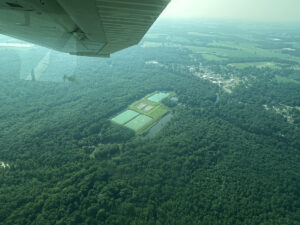News
Riverkeeper dives in to help city head off storms
Posted on February 25th, 2021
New Bern suffered approximately $100 million in damage during Hurricane Florence, most of it due to flooding, as picture here. (Photo by Raleigh News & Observer)

The City of New Bern is leading the way in hurricane resiliency for coastal Carolina towns.
The City sponsored a two-day virtual conference this week, inviting stakeholders from the broader community to pitch in on what a hazard mitigation plan looks like.
“They invited people from all over, whether they’re government officials or from nonprofits, like me, to be part of the discussion and give feedback — and give our expertise as to how problems can be addressed, and share problems the city may not even be not aware of,” said Sound Rivers’ Lower Neuse Riverkeeper Katy Hunt.
New Bern was one of many eastern North Carolina towns devastated by Hurricane Florence in September 2018 — the city on the banks of the Neuse River suffered approximately $100 million in residential and commercial damages, mostly due to flooding.
Hunt was part of this week’s discussion, which covered many aspects of resiliency, from historic preservation and public outreach and education to vulnerability and assessment and engineering solutions, including stormwater solutions such as investment in constructed wetlands.
The purpose of a hazard-mitigation plan is to not only prepare residents for extreme weather events such as hurricanes, but also determine ways to recover more quickly, which covers everything in the path of a major storm, from individual homeowners to city infrastructure.
“Based on all of the destruction devastation from Florence and the fact that, years later, people are not fully back, they’re still dealing with problems from Florence, they’re trying to make a plan to be prepared,” Hunt said.
Hunt weighed in on the public outreach and education discussion, which centered around an element instrumental to both preparation and recovery: getting information out to the public, and letting those impacted know what resources are available to them. Partnerships between organizations across effected communities are key, as evidenced by the diverse participation in the virtual conference, according to Hunt.
“There were so many people from all different walks of life, so many areas, because this is truly multifaceted problem,” Hunt said. “You’ve got to have people from a lot of different areas looking at it working together to solve it. I’m very pleased with the City of New Bern for bringing so many different voices to the table. Representation is key, and I think they did a pretty good job with that. … New Bern wants to be an example for other coastal communities. They want other towns and coastal communities to look at how they can prepare for sea-level rise and climate change, how to be prepared and resilient.
“This was step one — making a plan to make a plan. This is not the end of public input on these plans,” Hunt said.
For more information about resiliency efforts in New Bern visit the City of New Bern’s website here.
Related News

Riverkeeper monitoring Tar-Pamlico Water Trail
July 25th 2024

Rain ramps up trash-trap cleanouts
July 25th 2024

Riverkeeper, intern take on emergency trash trap cleanout
July 25th 2024

Tar-Pam Riverkeeper investigates Cub Creek turbidity
July 25th 2024

Heavy rains lead to sky-high turbidity on Lick Creek
July 25th 2024

Riverkeeper: What goes up, must come down
July 18th 2024

Greenville’s trash trap gets emergency cleanout
July 18th 2024

Sound Rivers gets close up of cyanobacteria
July 18th 2024

